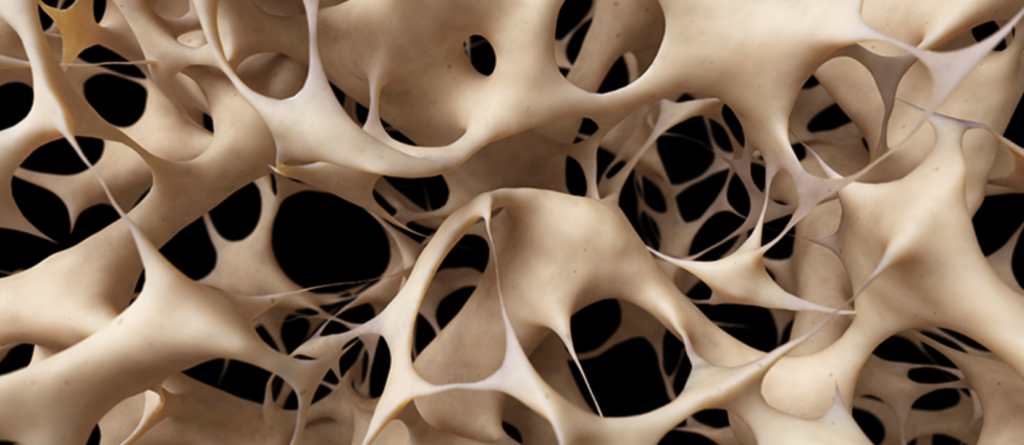OSTEOPOROSIS

The term ‘Osteoporosis’, which means “porous bones”, refers to a medical condition that causes bones to turn weak and brittle, leaving the bones at a greater risk of sudden bone fractures. Osteoporosis reduces bone mass and strength. This allows the bone to easily fracture even when carrying out simple day-to-day activities.
The internal structure of a healthy bone consists of small spaces which give the bone a rigid and relatively light form. Osteoporosis typically increases the size of these spaces, thereby causing the mass and mineral density of the bone to decrease.
Although osteoporosis can occur in people of any age and race, this condition occurs commonly among white and Asian women who have passed the age of menopause. Osteoporosis commonly affects the bones of the spine, hip, and wrist.
What’s the Symptoms of Osteoporosis?
Osteoporosis does not often present clear symptoms in the early stages of bone loss. Some of the symptoms that may occur at the early stages of osteoporosis may include weak and brittle nails, receding gums, and weakened grip strength.
An individual with this condition may experience certain signs and symptoms once osteoporosis starts causing severe damage to the bones. These signs and symptoms may include a gradual loss of height, severe back or neck pain, abrupt change in posture, shortness of breath, and fractures that occur after mild activity.
What’s the Causes and Risk Factors of Osteoporosis?
Osteoporosis occurs commonly due to bone loss from calcium deficiency. The bones in young individuals mostly under the age of thirty break down and get replaced continuously. As the individual gets older, the breakdown cycle occurs faster than the build-up cycle and the bones start to lose calcium –the mineral responsible for hardening bones. The calcium loss causes the small spaces in the bones to grow larger and this, in turn, weakens the internal structure of the bone. Although the loss of bone mass remains a natural part of aging, the risk of getting severe osteoporosis may increase if the individual has a family history of osteoporosis, lives a sedentary lifestyle, or possesses a thin or small frame.
Other factors that may increase the likelihood of osteoporosis include:
- Estrogen deficiencies in women
- Low calcium intake and eating disorders
- Heavy smoking and drinking
- Long-term use of steroids and other medication
- Certain medical conditions such as celiac disease, cancer, inflammatory bowel disease, kidney or liver malfunction, and rheumatoid arthritis.
How do Spinal Specialists Treat Osteoporosis?
Basic treatment for osteoporosis may include vitamin and mineral supplements, resistance or weight-bearing exercise, and medication. A spinal specialist may recommend certain medications such as a bisphosphonate, to help limit bone breakdown and lower the risk of an osteoporotic fracture. These medications may also help to lower the risk of hip and back fractures. A spinal specialist may also recommend medications such as anabolic agents to help build bone density in people with osteoporosis.
How do Spinal Specialists Diagnose Osteoporosis?
Bone Mineral Density (BMD) tests, also known as dual-energy X-ray absorptiometry (DEXA or DXA) scans, remain the most reliable means of diagnosing osteoporosis. These painless scans make use of a small amount of radiation to determine how solid the bones of the spine, hip, or wrist look. A spinal specialist will recommend a DXA scan instead of a regular x-ray as DXA scans effectively detect osteoporosis in the early stages.
If You need a Fort Worth Neurosurgeon, Contact Longhorn Brain & Spine Immediately To Get a Consultation.
References
Osteoporosis overview. National Institute of Arthritis and Musculoskeletal and Skin Diseases. https://www.bones.nih.gov/health-info/bone/osteoporosis/overview.
Wells G, Cranney A, Peterson J, Boucher M, Shea B, Robinson V, Coyle D, Tugwell P (January 2008). “Risedronate for the primary and secondary prevention of osteoporotic fractures in postmenopausal women”.
Rosen HN, et al. Overview of the management of osteoporosis in postmenopausal women. https://www.uptodate.com/contents/search.
Kim DH, Vaccaro AR (2006). “Osteoporotic compression fractures of the spine; current options and considerations for treatment”. The Spine Journal. 6 (5): 479–487
Vitamin D fact sheet for health professionals. Office of Dietary Supplements. https://ods.od.nih.gov/factsheets/VitaminD-HealthProfessional.
